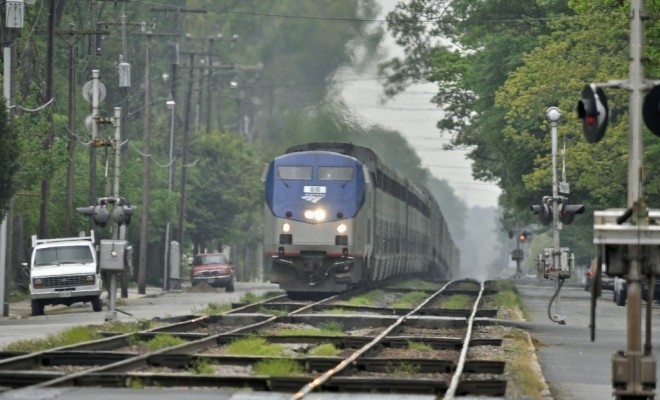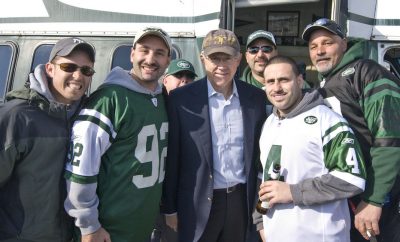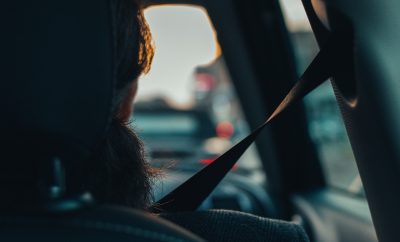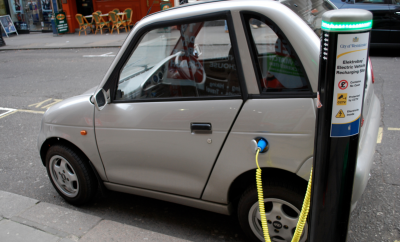 Image courtesy of [John H. Gray via Flickr]
Image courtesy of [John H. Gray via Flickr]
Business & Economics
Fatal Amtrak Derailment Casts Light on a Forgotten American Industry
Recently an Amtrak train traveling the busy northeast corridor route near Philadelphia derailed at a high speed, killing eight people and injuring more than 200. While experts weigh in over the speed of the train, the state of the engineer, and whether the locomotive was struck by a foreign object, many other people are now concerned about a different matter: the safety of trains in the United States. Read on to learn about the development of the train industry in the U.S., the rules and regulations that trains must follow, and considerations moving forward in light of the recent, horrific Amtrak crash.
Locomotives: The American Backstory
The first charter for a railroad in North America was granted to John Stevens in 1815. The same man also tested the first steam locomotive in the United States, nine years later in 1826. A railroad boom began in 1840, stemming from the northeast. However, this initial expansion was beset by unregulated practices and differing track gauges, which kept the lines from unifying. Individual owners of regional charters fought over territory. This chaos led to dangerous conditions for passengers and cargo traveling by rail.
As track mileage continued to expand rapidly, the rail industry achieved one of its greatest moments with the completion of the transcontinental railway in 1869 in Promontory Point, Utah. Starting in the 1880s and continuing through the 1920s, rail companies enjoyed greatest success. This was in part due to owners finally agreeing to standardize track gauge size and the development of a number of safety features that also improved efficiency. Ultimately, 1916 served as a peak year, with rail mileage reaching an all time high in the United States and stretching a total of 254,000 miles.
This expansion would come to a halt in the 1930s however, with the rise of individual automobiles and continue to stagnate throughout the 1940s and 50s following WWII. In the 1960s train companies began merging or going bankrupt, as passenger and freight numbers continued to dwindle. In 1971 Amtrak, a government supported system that dealt primarily with passenger traffic, was created. Even with government support however, the train network nationwide would likely have collapsed without a move towards deregulation in 1980. This move allowed the remaining companies to negotiate better rates and drop routes that were unprofitable.
This renaissance has continued into the present, as companies have merged into larger and larger entities. Freight has also returned to rail in large numbers, so much so that it is actually in danger of overwhelming the current system. Passenger travel has also increased, as people seek to avoid traffic and relax during commutes. The following video gives an overview of the history and development of railroads in the U.S.:
Trains By the Numbers
People
In the 2014 fiscal year, 30.9 million people rode Amtrak trains. During that same year 11.6 million passengers rode along the Northeast Corridor route, where the recent accident occurred. This was a 3.3 percent increase from the year before. In fact, this route is so popular that it actually accounts for 77 percent of combined rail and air travel between Washington DC and New York. These numbers would likely be even higher, except that Amtrak suffers from outdated infrastructure and has its efficiency hampered by freight trains using the same rails.
Freight
So exactly how much freight do these cumbersome trains move each year in the U.S.? In 2010, approximately 1.7 billion tons of freight were transported on rails, the last year with complete data. This accounted for 16 percent of the total freight shipped within the U.S. and equated $427 billion dollars. The industry is dominated by seven major carriers that employ 175,000 people. The number is expected to grow in the future, but is currently stagnant due to old infrastructure and insufficient investment.
Incidents
With all these people and things being moved by rail, the next questions is how likely are accidents like the one outside of Philadelphia? The answer is extremely unlikely. In fact, a person is 17 times more likely to be involved in a car accident than a train accident. While some of this can be explained by the obvious fact that most people travel in cars more than they travel in trains, the accident rate is also lower. There’s just .43 accidents per billion passenger miles for train travel versus 7.3 accidents per billion passenger miles for cars.
In addition, when rail accidents do occur, they usually do not involve passengers, as most rail traffic is moving freight. Thus, while 1,241 derailments occurred last year, there were few injuries. Furthermore, while the number of derailments may seem fairly high, it is less than half the number seen just thirty years ago. Most of the derailments that do still occur are a result of track conditions like the ones being blamed in the recent high profile crash. Experts worry that these are a result of underfunding, especially when it comes to Amtrak. This is the case even with ridership growing in the Northeast corridor route because Amtrak must spread its revenue across all its routes and many of them don’t make a profit.
Rules and Regulations
Benefits of Deregulation
As touched on earlier, the railroad industry actually experienced deregulation in the 1980s. The railroad industry wasn’t doing well, and needed to become more flexible in order to survive. Thanks to two separate acts passed in Congress, in 1976 and 1980 respectively, a collapse of the railroad industry was avoided. Basically both these acts provided greater flexibility to railroad companies to negotiate rates, change routes, and merge to stave off insolvency. While fears grew of monopolies, these acts were also designed to lower the cost on entry into rail travel and transport, which was supposed to prevent any one company from dominating the industry. Since these acts went into effect, the rail industry has enjoyed a strong comeback. Additionally, deregulating the rail industry may have also improved infrastructure, as the large companies that have come to dominate rail traffic can afford to reinvest in improving safety and the technology that guides their trains.
Thus, while the technology and knowledge exists to improve safety and prevent accidents like the one in Pennsylvania, everything ultimately comes back to money. In 2008, Congress passed a bill requiring trains to implement a system known as positive train control. This utilizes a number of technologies to sense how fast a train is moving and slow it down if necessary. However while this system was in place on the tracks going the opposite direction it was not yet in position on the tracks heading northbound towards Philadelphia. The accompanying video explains some of the safety measures in place, particularly positive train control:
There are other measures in place to alert the conductor and slow down the train as well. If the conductor does not alter the train’s trajectory in any way for a certain amount of time, bells go off in the cabin to alert him or her. Additionally, the train is also supposed to slow itself down, but it was unclear if these safeguards were initiated before the crash.
Money Troubles
However, in its 2008 decision, Congress required Amtrak to bid for the communications channels required to send and receive signals. For an already cash-strapped system that was also facing major budget cuts, this was a deadly requirement. Implementing this technology costs $52,000 dollars per mile and must be universally applicable to a variety of trains that use different technology. Nonetheless, despite all these challenges, the Amtrak system was actually one of the leaders and was one of the few on pace to complete the required installation by 2018.
Following the crash however, Congress vetoed a bill being pushed by President Obama that called for $1 billion dollars in additional funding for Amtrak. This funding is clearly needed not just because of this crash but also because of how Amtrak compares to foreign train systems. In the UK for example, this type of braking technology has been in place for nearly ten years. This is also true in other more train-centric countries such as France and Japan.
Shipping Oil
Along with recent concerns over rail safety in general, there are long standing worries over trains carrying oil. Due to the nation’s energy boom, trains are increasing being relied upon to transport oil. For example, in 2012 trains shipped more than 40 times the amount of oil they did just four years earlier, an amount which doubled again in 2013. The video below documents the rise and danger of shipping oil by rail:
This increased traffic has also led to an increase in the number of accidents. In 2014 there were 141 incidents termed “unintentional releases” of oil. The year before, while there were less individual incidents, even more oil was spilled, about 1.4 million gallons. For some perspective, that amount was more than all the oil that had ever been spilled by train transport to that point. These spills and accidents can lead to massive explosions, deaths and contaminated ecosystems. The increasing threat is so troubling that some people are calling for more pipelines to be built, rehashing the Keystone Pipeline debate.
Thus, while all trains are facing tighter rules and regulations, those carrying oil and gas are facing the most stringent changes to protocol. In new rules outlined at the beginning of May, more durable containers are now required for transporting fuel in the event of a crash. Additionally, trains are required to go no faster than 30 miles an hour unless they have electronic brakes. This action was part of a joint announcement in conjunction with Canada. It was also in the wake of a number of crashes involving fuel shipments, including four this year alone. This has also rekindled the argument over lack of funding and overly tight timelines.
Conclusion
The crash of an Amtrak train along the nation’s busiest passenger rail route has raised fears over train safety. These fears are compounded by a rail industry facing budgets cuts and relying on outdated technology. However, the rate of crashes and derailments remain low, especially in relation to other types of transportation such as cars. Nevertheless, in the future more investment and infrastructure improvements must be made in order to prevent accidents, like the one outside of Philadelphia, from repeating themselves. Greater efforts must also be made and continue to be made to regulate the usage of trains in moving massive quantities of oil, which has proven very dangerous. The rail system is the unsung and often forgotten cog of the transportation system in the U.S. But, it only takes one accident to put concerns over its safety back on America’s one mind.
Resources
American-Rails: Railroad History: An Overview of the Past
The New York Times: Amtrak Says Shortfalls and Rules Delayed its Safety System
Washington Post: Trains and Carrying and Spilling a Record Amount of Oil
CNN: Amtrak Installs Speed Controls at Fatal Crash Site
Guardian: Amtrak’s Northeast Corridor
Center for American Progress: Getting America’s Freight Back on the Move
Vox: 4 Facts Everyone Should Know about Train Accidents
Hofstra University: Rail Deregulation in the United States
Guardian: Amtrak How America Lags Behind the Rest of the Developed World on Train Safety
Wall Street Journal: U.S. Lays Down Stricter Railcar Rules








Comments